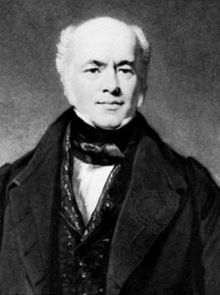Francis Baily
Francis Baily (* 28. April 1774 in Newbury , Berkshire , † the thirtieth August 1844 in London ) was an English astronomer . He was particularly concerned with star catalogs , on which he published numerous works. He described the phenomenon of Bailyschen beads (ger .: Baily's beads or Perlschnurphänomen) and was later president of the Royal Astronomical Society .
Live and act
Baily initially embarked on a commercial career. After his training he traveled to the as yet unpopulated areas of North America in 1796/97 . Upon his return, he worked from 1799 on the London Stock Exchange ( London Stock Exchange ). In the years 1802 to 1810 he wrote several publications on leases , pensions and insurance , which gave him a high reputation and a secure income. In 1825 he retired from finance to devote himself entirely to astronomy .
Baily was instrumental in founding the Royal Astronomical Society as early as 1820. In 1827 he received the gold medal of the Royal Astronomical Society for his contribution to the creation of a catalog with 2881 stars ( Catalog of 2881 Stars ).
The revision of the Nautical Almanac in 1829 goes back to his initiative . In 1832 Baily was elected to the American Academy of Arts and Sciences . In 1837 he recommended the revision and summary of the star catalogs by Jérôme Lalande and Nicolas Louis de Lacaille , which contained 57,000 stars.
The British Association's Catalog of 8377 Stars was created and published in 1845. Sighted beyond, and he revised the older catalogs and records of Ptolemy , Ulugh Beg , Tobias Mayer , Tycho Brahe , Edmond Halley and Hevelius .
During the total solar eclipse of May 15, 1836, he observed a phenomenon from Roxburghshire that is now known as "Baily's pearls" or the pearl-string phenomenon . It is caused by the unevenness of the moon's edge , which makes "pearls of light" visible shortly before and after the total phase. His lively description published about it was the trigger for the sending of "darkness expeditions" all over the world. Baily himself observed the total solar eclipse on July 8, 1842 from Pavia .
He completed Henry Foster's pendulum experiment to determine the flattening of the earth , which he determined to be 1 / 289.48. His work to determine the mean density of planet earth using the method of Henry Cavendish resulted in a value of 5.66 g / cm³.
In 1836 he was accepted as a corresponding member of the Académie des Sciences and in 1842 of the Prussian Academy of Sciences .
The moon crater Baily has been named after him since 1935 and the asteroid (3115) Baily since 1986 . The same has been true since 1957 for the Baily Head , a headland of Deception Island in the archipelago of the South Shetland Islands in Antarctica .
Works
- The Doctrine of life annuities and assurances, analytically investigated and explained . London (1810)
- The Catalogs of Ptolemy , Ulug Begh , Tycho Brahe , Halley , Hevelius , deduced from the best Authorities . London (1843)
- Catalog of stars of the British Association for the advancement of science . London (1846)
Individual evidence
- ^ List of members since 1666: Letter B. Académie des sciences, accessed on September 15, 2019 (French).
- ^ Members of the previous academies. Francis Baily. Berlin-Brandenburg Academy of Sciences , accessed on February 17, 2015 .
Web links
- Letter from the Royal Astronomical Society on the occasion of the award of the gold medal in 1827
- Letter from the Royal Astronomical Society on the occasion of the award of another gold medal in 1843
- Obituary by John Herschel
- Entry to Baily; Francis (1774-1844); Astronomer in the Archives of the Royal Society , London
- F. Baily publications in the Astrophysics Data System
| personal data | |
|---|---|
| SURNAME | Baily, Francis |
| BRIEF DESCRIPTION | English astronomer |
| DATE OF BIRTH | April 28, 1774 |
| PLACE OF BIRTH | Newbury , Berkshire |
| DATE OF DEATH | August 30, 1844 |
| Place of death | London |
